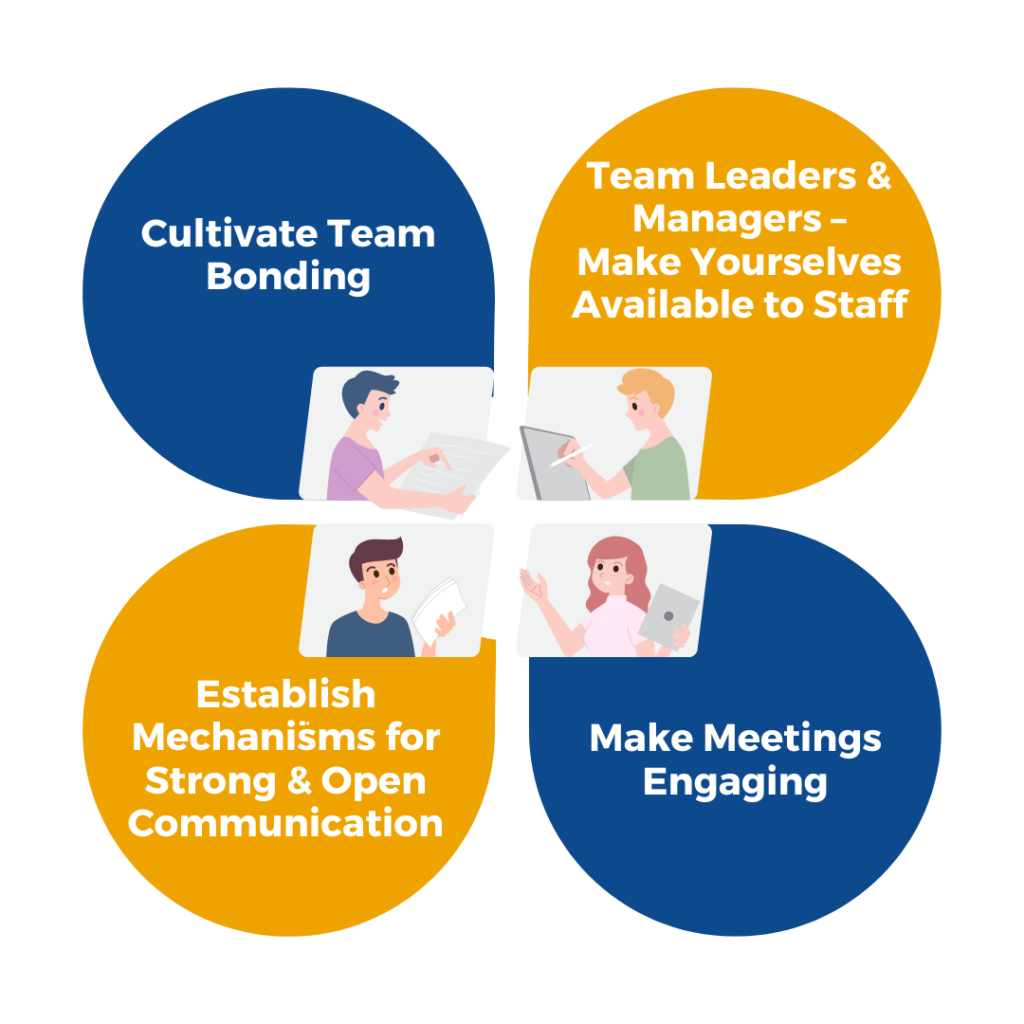Staying Connected: How to Build Strong Nonprofit Culture in a Hybrid Workplace
co-authored by Humberto Camarena, Senior Consultant
This article is the result of a collaborative effort between our team and our talented intern, working together to share our insights on virtual workplace culture.
The goal:
Intentionally build a strong organizational culture in a hybrid or virtual environment by implementing these simple, yet effective practices.
The challenge:
Developing a strong work culture in a hybrid or entirely virtual environment can be difficult. It takes intentionality and an entirely different approach than the spontaneous culture that can arise in an in-person setting through casual, watercooler conversations. In a virtual setting, staff may be in transit, have noise or distractions present during meetings, they may not be able to have their cameras on, or they might be working independently and not see their colleagues outside of structured meetings. All of this can lead to a lack of engagement, community, collaboration, and commitment within the organization.
Why it matters:
Intentionally building your organizational culture is extremely important for organizations. It supports collaboration, connects staff to the mission, reduces turnover, increases efficiency, minimizes miscommunication, and, ultimately, helps the organization achieve its goals. If culture is lacking, the organization is at risk of staff not understanding its values and priorities, and people end up leaving, because they do not feel supported.
Thankfully, there are various tools and practices available for leaders to shape their organizational culture in a way that is aligned with their mission and values.
Bottom line:
Hybrid culture is the new normal. We have to develop systems and practices to make this context work for our organizations. These four basic changes can greatly improve organizational effectiveness and promote success in the long run.

Practice #1: Cultivate Team Bonding
Why it matters:
Team bonding activities help team members feel more connected and less isolated when working from home. When team members know each other better and have constructive relationships, they are more likely to share resources, reach out for support, and ask clarifying questions, even when they are not working in the same department. When a team feels bonded with each other, work tends to be more productive, teams are less siloed, and a higher morale is shared throughout the organization.
Strategies to take action:
Get Started |
|
Go Deeper |
|
Bottom line:
The feeling of isolation is real! Team bonding facilitates a feeling of collaboration and presence to connect more fully with colleagues. These activities should be ongoing to help coworkers establish rapport on a personal and professional level.
Practice #2: Establish Mechanisms for Strong and Open Communication
Why it matters:
When organizations are able to cultivate effective communication, it leads to stronger trust, fewer misunderstandings, increases in productivity, greater clarity of work delegation, and robust feedback for continuous improvement. No single communication strategy is a silver bullet. Instead, a series of coordinated efforts is necessary to ensure communication is strong and effective.
Key areas to address in your internal communication strategies:
- Changes that are happening in the organization
- New systems/policies being implemented
- Updates on key strategic tasks
- Professional development opportunities
- Task assignments and deliverables
- Organizational responses to news and events
- Feedback opportunities for staff to voice ideas, frustrations, and concerns
- Celebrations and staff recognition
Strategies to take Action:
Get Started |
|
Go Deeper |
|
Bottom line:
Open communication helps get all staff on the same page about the organization’s goals and values, making employees feel more connected to daily operations and the overall mission.
Practice #3: Make Meetings Engaging
Why it matters:
When was the last time you walked out of a meeting feeling like it was an excellent use of time? What was it that made the meeting particularly effective? How often do you have engaging meetings? When employees feel empowered to participate and feel engaged with the content of a meeting, it can help elevate innovation, motivation, and connection. Engaging meetings help the content “stick,” keep the energy high, and put staff in the driver’s seat, actively and effectively contributing their time and resources towards the organization’s mission and goals.
Strategies to Take Action:
Get Started |
|
Go Deeper |
|
Bottom line:
Engaging meetings help boost productivity and keep employees committed to and excited about the organization’s goals and mission.
Practice #4: Team Leaders and Managers – Make Yourselves Available
Why it matters:
To make employees feel comfortable asking questions and coming to them for help, team leaders and managers need to make themselves available. This is especially true in a virtual environment. Unlike an in-person setting, staff can’t just “pop in” to a person’s office or run into each other in the hallway to clarify questions or run something by you. It is important to not only create a feeling of openness and support between team members and leadership, but also to carve out virtual opportunities for those interactions to feel natural. By showing you are available and willing to help, you can build a stronger connection and a sense of camaraderie, trust, and accountability between staff and leadership.
Strategies to Take Action:
Get Started |
|
Go Deeper |
|
Bottom Line:
When managers make time for their employees, they feel valued, develop stronger relationships, and feel more connected to their team goals and objectives—especially when onboarding virtually. This helps improve engagement, productivity, and retention.
Tips for Success
Building a strong nonprofit culture in a hybrid workplace is a process that requires time, effort, and dedication. As we have seen, culture isn’t built overnight, and it requires a deliberate effort to shape and maintain it. It is important to choose the tools and tactics that work best for your organization, taking into account your unique needs, resources, values, and goals.
Offering many different touchpoints for staff to engage in and build your culture is also key. As you go about implementing, it is essential to ensure follow-through and have different leaders and staff responsible for working on your organizational culture. This shared accountability ensures that everyone is invested in maintaining a strong culture and that efforts to do so are sustainable over time.
By following these tips and remaining committed to building a strong nonprofit culture, organizations can foster a positive work environment that supports their mission and goals.


Comment section
1 thought on “Staying Connected: How to Build Strong Nonprofit Culture in a Hybrid Workplace”